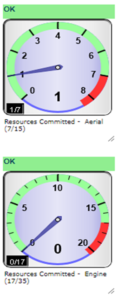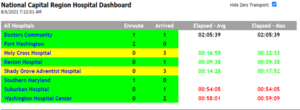In Fiscal Year (FY) 2013, Prince George’s County Fire and Emergency Medical Services (EMS) Department (PGFD) began a pilot program to assess the efficacy of the FirstWatch real-time situational awareness application. Supported by Maryland-National Capital Region Emergency Response System (MDERS) funds, this program aimed to provide PGFD leadership with a near-real-time view of the department’s operations that could be accessed through a single platform.
Previously, leaders relied upon multiple sources of information such as Computer Aided Dispatch (CAD) Systems, electronic Patient Care Reporting (ePCR), Records Management Systems (RMSs), and other platforms to determine the status of the department’s operations and performance. The reliance on numerous sources of information to maintain a holistic view of current operations created significant challenges in maintaining real-time situational awareness. FirstWatch resolves these challenges by integrating multiple data sources and combining all data inputs into actionable information via an internet browser or mobile application.
Real-Time Situational Awareness and Data Analytics
FirstWatch connects to data feeds from CAD systems, ePCR, and RMSs to provide real-time situational awareness. The FirstWatch platform aggregates these data feeds into a single stream of actionable information that authorized users can access. Additionally, FirstWatch conducts pre-configured analyses of the aggregated data and notifies identified personnel when user-defined trigger points are met or exceeded. An example of one such trigger is when a specified number of ambulances are unavailable for dispatching due to current use on calls or based on an out of service status.

In support of its analytics, FirstWatch provides data visualization via gauges, dashboards, and other tools to provide a more user-friendly interface. Gauges, shown in Figure 1, illustrate the current capacity of an identified trigger threshold. Dashboards, as shown in Figure 2, synthesize larger, more complex data to provide a comprehensive overview.
One notable dashboard currently deployed within the NCR is the Hospital Transport Status Dashboard. This dashboard provides fire departments and healthcare facilities staff with the awareness of the current number of ambulances at or en route to every hospital within the region at any given time. Data such as arrival on scene, en route to the hospital, arrival at the hospital, and clearing the call times are available for each ambulance from every fire department, with relevant time stamps included for each status change. As many healthcare facilities operate near capacity on a regular basis, this dashboard alleviates potential capacity burdens by providing healthcare and EMS providers with the information to identify service backlogs. Once a backlog is identified, EMS or healthcare providers can divert new patients to other nearby facilities with existing capacity.

Additionally, FirstWatch provides other tools to participating agencies such as automated auditing of ePCRs to ensure quality assurance and quality improvement. Maryland-National Capital Region fire, rescue, and EMS agencies generate thousands of ePCRs annually. Previously, personnel manually audited these records for specific criteria, quality indicators, or other information. The FirstPass module within FirstWatch reviews each ePCR for user-defined criteria and sends automated alerts to relevant personnel, such as the administration of a specific medication or medical intervention. These alerts identify which ePCRs may require manual review or follow-up with providers, patients, or healthcare facilities.
FirstWatch within the Maryland-National Capital Region
In the Maryland-National Capital Region, PGFD and Montgomery County Fire Rescue Service (MCFRS) leadership utilize the FirstWatch application daily to maintain awareness on current operating status. Field personnel rely on the information collected by the FirstWatch application to make informed decisions regarding patient transport destination, offload, and transfer time, thus improving the availability of ambulances across the region.
In addition to Montgomery and Prince George’s Counties, the MDERS FirstWatch program provides FirstWatch licensing, maintenance, and access for the entire National Capital Region, including:
- District of Columbia
- City of Alexandria
- Arlington County
- City of Fairfax
- Fairfax County
- Loudon County
- Prince William County
Each jurisdiction’s fire, rescue, and EMS system can further customize FirstWatch better meet individual data needs and inform decision making. As FirstWatch develops new tools to assist public safety, agencies within the National Capital Region will continue to advance their use of the program to provide enhanced situational awareness across the region.


